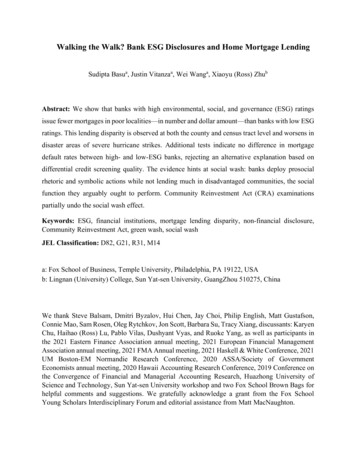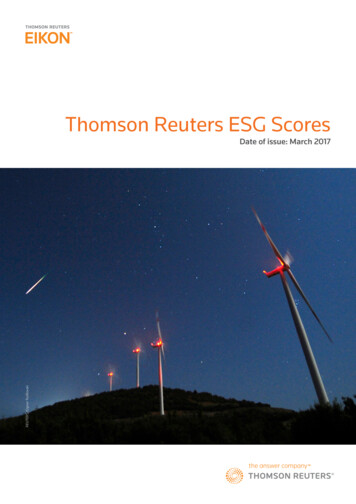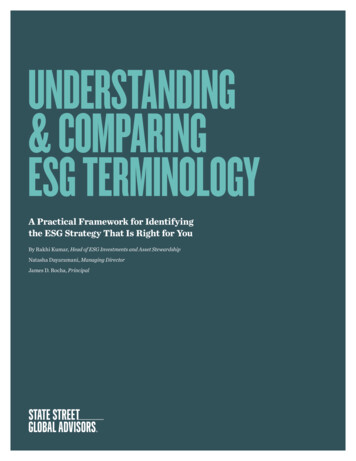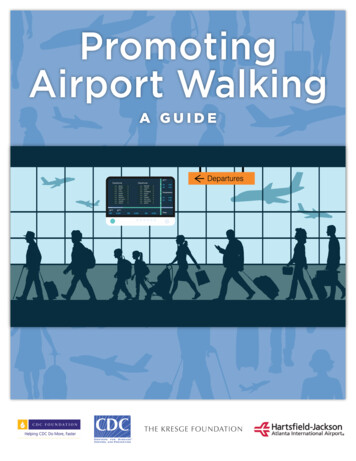
Transcription
Walking the Walk? Bank ESG Disclosures and Home Mortgage LendingSudipta Basua, Justin Vitanzaa, Wei Wanga, Xiaoyu (Ross) ZhubAbstract: We show that banks with high environmental, social, and governance (ESG) ratingsissue fewer mortgages in poor localities—in number and dollar amount—than banks with low ESGratings. This lending disparity is observed at both the county and census tract level and worsens indisaster areas of severe hurricane strikes. Additional tests indicate no difference in mortgagedefault rates between high- and low-ESG banks, rejecting an alternative explanation based ondifferential credit screening quality. The evidence hints at social wash: banks deploy prosocialrhetoric and symbolic actions while not lending much in disadvantaged communities, the socialfunction they arguably ought to perform. Community Reinvestment Act (CRA) examinationspartially undo the social wash effect.Keywords: ESG, financial institutions, mortgage lending disparity, non-financial disclosure,Community Reinvestment Act, green wash, social washJEL Classification: D82, G21, R31, M14a: Fox School of Business, Temple University, Philadelphia, PA 19122, USAb: Lingnan (University) College, Sun Yat-sen University, GuangZhou 510275, ChinaWe thank Steve Balsam, Dmitri Byzalov, Hui Chen, Jay Choi, Philip English, Matt Gustafson,Connie Mao, Sam Rosen, Oleg Rytchkov, Jon Scott, Barbara Su, Tracy Xiang, discussants: KaryenChu, Haihao (Ross) Lu, Pablo Vilas, Dushyant Vyas, and Ruoke Yang, as well as participants inthe 2021 Eastern Finance Association annual meeting, 2021 European Financial ManagementAssociation annual meeting, 2021 FMA Annual meeting, 2021 Haskell & White Conference, 2021UM Boston-EM Normandie Research Conference, 2020 ASSA/Society of GovernmentEconomists annual meeting, 2020 Hawaii Accounting Research Conference, 2019 Conference onthe Convergence of Financial and Managerial Accounting Research, Huazhong University ofScience and Technology, Sun Yat-sen University workshop and two Fox School Brown Bags forhelpful comments and suggestions. We gratefully acknowledge a grant from the Fox SchoolYoung Scholars Interdisciplinary Forum and editorial assistance from Matt MacNaughton.
1. IntroductionThe notion that companies should behave in socially responsible ways beyond maximizingprofit, once dismissed by many scholars and business leaders as untenable (Pigou 1920; Friedman1963, 1970), is now popular. The number and scope of corporate claims about their environmental,social, and governance (ESG) performance has exploded recently. At the start of 2020, about 90%of firms in the S&P 500 index disclosed ESG data, and more than 17 trillion was invested infunds that select portfolio firms using explicit ESG criteria. 1 Many asset managers and datacompanies produce ESG ratings, often relying on firms’ own disclosures for ESG-related data.However, some regulators question the truthfulness of these ESG disclosures, arguing that theymisrepresent companies’ actual social or environmental practices (Peirce 2019, Roisman 2020).In their view, firms talk the ESG talk, but often do not walk the ESG walk.We study corporate social responsibility in commercial banks whose main business role—providing credit to local communities—can create widespread benefits. We study if banks withhigh ESG ratings originate more home-purchase mortgage loans in poor localities than banks withlow ESG ratings. Our inquiry is motivated by the long-standing principle that banks are sociallyobliged to expand home mortgage access in underserved localities while maintaining safe andsound operations (Community Reinvestment Act (CRA) of 1977; Bernanke 2007). 2 However,credit market failures and discrimination have historically impeded lending to otherwisecreditworthy borrowers in poor neighborhoods (Lang and Nakamura 1993; Barr 2005). Given thesocioeconomic benefits of homeownership (Dietz and Haurin 2003), the interplay of banks’ ESGand mortgage credit provision, especially in poor localities, merits close inspection.See US SIF (The Forum for Sustainable and Responsible Investment) Foundation’s 2020 Report on US Sustainableand Impact Investing Trends. We use ‘ESG’ synonymously with “corporate social responsibility.”2When introducing CRA in the Senate in 1977, Senator William Proxmire (D-Wisconsin) said “a public charterconveys numerous economic benefits and in return it is legitimate for public policy and regulatory practice to requiresome public purpose."11
Our sample combines ESG data from Refinitiv with home-mortgage-lending data releasedby the Federal Financial Institutions Examination Council (FFIEC) under the Home MortgageDisclosure Act (HMDA) from 2002 to 2018. To separate banks’ mortgage supply from thepotentially confounding effects of local mortgage demand, our empirical identification focuses onthe within-locality-year variation in mortgage lending. Our rationale is that banks with differingESG ratings face similar mortgage demand for properties in the same locality in a given year, asevidenced by similar loan application characteristics for banks lending in the same locality.We have two main findings. First, high-ESG banks originate fewer home purchase loansthan low-ESG banks annually—in number and dollar amount—in poor counties. Second, withinthe same county, high-ESG banks are less likely than low-ESG banks to lend on properties in poorcensus tracts that should be served by both types of banks under CRA. These findings are notdriven by bank size, since the correlation between bank ESG ratings and bank size is low andexcluding the largest banks or multinational banks does not change the results much. The resultshold using only the social (‘S’) component of ESG ratings, extend to small business lending, arenot driven by differential underwriting standards between high- and low-ESG banks, and persistacross alternative ESG measures from Bloomberg, MSCI/KLD, and S&P Global.To assess causality, we instrument a bank’s ESG rating with the voting percentage for theDemocratic presidential candidate in the bank’s headquarter state in the last presidential election.This instrument relies on firms in Democratic states being more likely than firms in Republicanstates to promote ESG practices (Di Giuli and Kostovetsky 2014). Moreover, states’ electionoutcomes vary over time, providing plausibly exogenous time-series variation to banks’ ESGpressure. Using a two-stage least squares (2SLS) framework, we show that increases in banks’2
ESG ratings correspond to significant declines in the banks’ mortgage lending in poorneighborhoods, supporting our main inference.We propose a social wash effect: Firms selectively undertake and advertise symbolicprosocial activities in their ESG disclosures to divert attention from their weak lending records inpoor areas. 3 Several tests corroborate this effect. First, we use severe hurricanes as a setting, wheremortgage demand rises in disaster areas as residents seek to rebuild their destroyed properties, butso do banks’ social wash incentives. Banks might avoid lending in poor disaster areas becauseproperties there often lack flood insurance, which impedes recovery, depresses local home values,and increases mortgage default risk. Meanwhile, hyperactive media attention/news coveragearound severe hurricanes, such as Hurricane Katrina, likely prods banks to project an image ofsocial altruism. We show that high-ESG banks are more likely than low-ESG banks to haltmortgage lending in low-income counties hit by big hurricanes where they previously lent.Second, we test whether CRA rules and enforcement mitigate the ESG–mortgage lendingincongruence. Under CRA, banks are examined periodically on their lending in low-incomecommunities. Banks failing the exam are prohibited from opening new branches or engaging inmergers and acquisitions until their lending record improves. We report that high-ESG banks’lending curtailment in low-income areas is mitigated, though not eliminated, among banks ratedhighest in recent CRA exams. High-ESG banks also increase mortgage lending more quickly inpoor localities after CRA rating downgrades. The collective evidence suggests that CRAenforcement partially undoes banks’ social wash behavior.This term parallels the better-known “greenwash,” which is the practice of communicating misleading and overlypositive information about a company’s environmental performance and the environmental impact of its products andservices (Lyon and Montgomery 2015; Flammer 2021). This term has evolved to also include firms’ exaggeration oftheir commitment to address social issues like employee treatment and workplace diversity, but is still primarilyassociated with environmental issues. We prefer social wash here because home mortgage lending creates societal(rather than environmental) value—increased homeownership, wealth accumulation, local price appreciation (givenexternalities associated with housing), lower local crime rates, etc. (DiPasquale and Glaeser 1999).33
Third, we use detailed HMDA loan application data to unpack how banks’ ESG ratingscovary with individual mortgage application decisions. We find that high-ESG banks are lesslikely than low-ESG banks to approve home mortgage loans in poor areas, after controlling forborrower characteristics like income, debt-to-income ratio, race, and ethnicity. However, highESG banks are just as likely as their low-ESG counterparts to offer high-yield loans. The pricingresult mitigates the concern that high-ESG banks’ poor lending record in low-income areas isdriven by innately risky borrowers selecting into high-ESG banks; if that were the case, we wouldexpect high-ESG banks to price in the risk with higher interest rates.Our study makes several contributions. First, our results suggest that bank managerspromoting ESG may not put their money where their mouths are. Our evidence suggests that suchmanagers can do more to back up their touted ESG credentials, for example, by lending in poorlocalities. Second, we show that current regulatory regimes, including CRA enforcement, do notfully curb disparate mortgage lending. Third, we advance a keen debate on the role of ESGpractices and disclosures (e.g., Moser and Martin 2012; Christensen et al. 2019; Grewal andSerafeim 2020; Larcker and Watts 2020; Raghunandan and Rajgopal 2021a, 2021b).2. Institutional background and hypothesesAs of December 31, 2019, total U.S. mortgage balances ( 9.56 trillion) constituted 68% oftotal household debt ( 14.15 trillion). 4 Banks enhance the economic health of communities bymeeting their housing credit needs. Banks have been criticized for historically reducing or refusingcredit access to minority or poor households and neighborhoods. “Redlining” labels bankers’practice of marking off neighborhoods (often in red lines) as “hazardous” for lending due to theirgeographical location and racial composition (Benston 1981; Holmes and Horvitz eractives/householdcredit/data/pdf/HHDC 2019Q4.pdf.4
To counter discriminatory lending practices, Congress enacted a series of laws aimed atequalizing access to home mortgages, including the Fair Housing Act of 1968 (FHA), the EqualCredit Opportunity Act of 1974 (ECOA, 15 U.S.C. § 1691), the Home Mortgage Disclosure Actof 1975 (HMDA, 12 U.S.C. § 2801), and the Community Reinvestment Act of 1977 (CRA, 12U.S.C. § 2901-2908). FHA and ECOA address racial discrimination in mortgage lending, whileCRA and HMDA more broadly address under-lending in low- and moderate-income communities.When enacting CRA, Congress stated that financial institutions have a ‘continuing and affirmative’obligation to help meet the credit needs of low- and moderate-income areas in which banks arechartered (12 U.S.C §2901). The CRA’s goal is to induce lenders to look harder for profitablelending opportunities in disadvantaged neighborhoods that they otherwise would avoid, within thebounds of safety and soundness standards.Although banks have substantially reduced discriminatory lending and information barriersin historically underserved markets, disparities in mortgage access persist. 5 Applicants from poorneighborhoods, and minority applicants who are more likely to reside in these areas, are morelikely to be denied a mortgage loan and charged higher interest rates, even after controlling forrelevant economic characteristics (e.g., Munnell et al. 1996; Ladd 1998; Bartlett et al. 2021). 6 Theunderserved and underbanked segment is especially vulnerable to predatory lending (e.g., Morgan2007), so access to traditional banking credit may protect them. The banking sector, as a quid proquo for governmental subsidies like federal deposit insurance and federal backstop, is arguablyRecent redlining cases brought by the U.S. Department of Justice against Cadence Bank and Trustmark NationalBank are sobering reminders that unequal access to mortgage credit, unjustified by the borrowers’ true credit quality,still hurts poor (and primarily minority) communities. As digital lending becomes increasingly popular, redlining cantake a subtler form via sophisticated algorithms that disparately affect poor households and communities (e.g., Bartlettet al. 2021). A recent investigation by Markup finds that in 2019, after controlling for publicly available loanapplication data, minority applicants are almost 50% more likely to be denied a mortgage than white applicants.6Munnell et al. (1996) was heavily criticized by Day and Liebowitz (1998) for data errors and Harrison (1998) forignoring relevant loan applicant data such as marital status and age, correcting for either of which made thediscrimination coefficient drop to zero.55
obliged to reduce structural inequalities and disparate lending in poor neighborhoods—most ofwhich are populated by minority borrowers (Barr 2005; Bernanke 2007). Mortgage financing isan important product for individual well-being, but also has societal effects. For example,increased homeownership can increase business opportunities and tax revenues.Given the lasting importance of homeownership for families’ prosperity and that mortgagelending is a core component of banks’ business, any discussion or metric of banks’ ESG (even ifit is just an umbrella term) must consider their mortgage lending to underserved home buyers, justas emitting less carbon dioxide ranks at the top of oil-and-gas firms’ ESG agenda.2.1 Social wash hypothesisWhether banks that purport strong ESG performance lend more in poor neighborhoods istheoretically unclear. On the one hand, banks can selectively undertake and promote symbolicESG actions to present a socially responsible public image but avoid tangible actions that generatereal social benefits. Banks with high ESG scores may not meet housing credit needs in poor areas;they may pay lip service to an ESG agenda. We refer to this as the social wash hypothesis.Some firms engage in social wash because it benefits them, at least in the short term. Firmsmarket themselves as socially or environmentally conscious rather than maximizing profitsbecause the public is increasingly enthusiastic about corporate goodness (Mishra and Modi 2016;Dyck et al. 2019). By disclosing prosocial efforts while obscuring antisocial ones, firms can placatepublic opinion and forestall attacks by activist groups (Dhaliwal et al. 2011; Grewal et al. 2019).Some consumers pay premium prices for products and services from socially conscious firms(Bhattacharya and Sen 2003; Berens, Van Riel, and Van Bruggen 2005; Servaes and Tamayo2013). Wall Street also incentivizes social wash. Asset managers’ fervor for socially responsibleinvestments pressures portfolio companies to adopt ESG strategies (Friedman and Heinle 2016;6
Chen et al. 2020). Although corporate social responsibility can create value in the long run, it iscostly in the short run and managers have a short time horizon because of their pay structure andthe stock market’s fixation on short-term earnings. Some managers likely overstate their ESGengagement to appease fund managers without sacrificing bottom line earnings. 7Organizational behavior theories posit that superficial conformity with social norms leadsto a disconnect between firms’ real actions and their external façades (e.g., Abrahamson andBaumard 2008; Cho et al. 2015). The lack of standardization, transparency, and enforcement forESG disclosures (see Christensen et al. 2019; Grewal and Serafeim 2020) offers managers flexiblereporting, increasing this disconnect. Unlike financial data, ESG data are not audited, and manycompanies lack adequate internal controls to limit ESG misstatements. While social wash is likelypervasive (Raghunandan and Rajgopal 2021a, 2021b), window dressing by banks can be especiallydamaging because of banks’ central role in providing financial services to local communities andhouseholds. Distorting the public’s perception about banks’ mortgage lending in poor areas, forexample, can lead to resource misallocations and prolong the communities’ economic struggle.Banks can raise their ESG metrics by providing overly positive narratives about policies,products, and performance (see Lyon and Montgomery 2015); adding visual imagery in corporateannual reports, websites, and social media (picture a family of four standing in front of their newlypurchased house smiling happily); participating in charity programs; selectively disclosingfavorable data; partnering with non-governmental organizations (NGOs); and more recently, byissuing or underwriting ESG-labelled instruments like green bonds whose proceeds are used toIn a commentary in The Wall Street Journal, Bebchuk and Tallarita (2020) report that most CEOs signed a newBusiness Roundtable statement of corporate purpose that prioritizes stakeholder value over shareholder value but didnot have these actions ratified by their boards of directors, suggesting that these firms’ actions are mostly for show.77
advance social/environmental goals. 8 We do not claim that all banks must lend in low-incomecommunities. There are rational reasons why some banks lend less than others in these areas—profit maximization, deposit network, underwriting standards, etc. Rather, it is the inconsistencyof what banks disclose and promote about their “social consciousness” versus what they actuallydo when ESG matters that is at the core of the social wash hypothesis. 9We formulate the social wash hypothesis as follows, in alternative form:H1a: Banks with higher ESG ratings issue fewer mortgage loans in poorer neighborhoodsrelative to banks with lower ESG ratings (Social Wash Hypothesis).To be sure, reasons other than social wash could lead to the same prediction. One reasonis that the marginal benefits of undertaking costly yet socially desirable activities to boost ESGcredentials are higher when banks have low ESG ratings, which would lead low-ESG banks tolend more in poor communities. Another possibility is that high-ESG banks have more prudentunderwriting practices and rationally reduce lending in low-income communities to mitigatedefault risk. Banks could substitute mortgage origination in low-income areas with investmentprograms designed to promote affordable housing and local economic development or lend in lessdeveloped countries. We empirically evaluate these alternatives in Section 5 and Online Appendix.In its 2016 social responsibility report, Wells Fargo boasted of its altruism—ranging from reducing greenhouseemissions to large donations to nonprofits and community organizations—while its employees opened millions offake accounts without customers’ consent and engaged in abusive cross-selling. Not all social wash is fraudulent—the Wells Fargo scandal might be an outlier—but many publicized ESG disclosures reflect a narrow (less costly)subset of the firm’s social actions that are misleading. Recent statements reported in The Wall Street Journal by mutualfund managers suggest that they are skeptical whether banks like JPMorgan that are issuing green bonds are trulygreen or just catering to socially conscious investors.9Although banks must publicly disclose their home mortgage lending data under HMDA, the complex anddisaggregated nature of the data makes it very difficult to decipher a bank’s lending patterns and thus discern anysocial wash behavior. Hartzmark and Sussman (2019) show that simply increasing the saliency of information aboutsustainability—for example, by repackaging or aggregating the data that is already publicly available to make themeasier to comprehend—changes the behavior of sophisticated investors.88
2.2 Social signaling hypothesisOn the other hand, if banks accurately disclose their social and environmental actions, thenbanks with high ESG performance will likely provide more home mortgages in low-income areasthan banks with low ESG performance. Under signaling theory, in markets with asymmetricinformation, high performers will reveal credible data about their performance to try to separatethemselves from low performers (Lys et al. 2015). In a separating equilibrium, high-ESG bankswill publicize their superior ESG performance, while low-ESG banks will not disclose.According to Bénabou and Tirole (2010), self-signaling plays an important role in drivingboth individuals’ and firms’ decisions to undertake and publicize their prosocial behavior—colloquially known as “do good and talk about it.” The equilibrium is one in which banks’ ESGdisclosures faithfully represent their true commitment, i.e., banks with better home mortgagelending in poor neighborhoods are those that achieve higher ESG scores. If a company consistentlyoverstates its corporate responsibility achievements, market participants will discern such behaviorand the signal will lose its credibility. We label this the social signaling hypothesis.The social signaling hypothesis does not require that all bank ESG metrics precisely reporteach of a bank’s multi-pronged social practices. Banks’ mortgage lending behavior, which oftendepends on various factors such as banks’ business models and strategic operations, also cannotbe reduced to a single metric. Rather, the hypothesis requires that social and communityengagements be positively correlated; a bank that does well in one prosocial dimension is expectedto do well in other prosocial dimensions given the bank’s overarching emphasis on social good.We formulate the social signaling hypothesis as follows:H1b: Banks with high ESG scores issue more mortgage loans in poor neighborhoods thanbanks with low ESG scores (Social Signaling Hypothesis).9
3. Sample Selection and Empirical Design3.1. Sample SelectionTable 1 details the sample selection. We obtain ESG data from Refinitiv of ThomsonReuters, which provides standardized ESG scores for listed companies since 2002. Firms’ ESGperformance is evaluated across three main dimensions (“pillars”)—environmental, social, andgovernance—based on many public data sources such as the firms’ annual reports, their corporatesocial responsibility reports, news media, and nongovernment organizations’ (NGO’s) websites.Each pillar comprises multiple subcategories, each of which is also assigned a numerical rating byRefinitiv based on 178 comparable metrics that make up the subcategories. 10 Environmental andsocial ratings are benchmarked against firms in the same industry (Thomson Reuters BusinessClassifications (TRBC)), and governance ratings are benchmarked against the country, facilitatingdirect comparison among peer firms. Refinitiv also discounts firms’ overall ESG scoring by ESGrelated controversies (such as business ethics issues or consumer complaints), which reduces thesize bias in ESG ratings. We use the controversy-adjusted ESG score in our analyses. We collectESG ratings for listed bank holding companies, which results in an initial sample of 915 annualESG observations associated with 181 bank holding companies over the period 2002-2018.We obtain home mortgage data from HMDA data compiled by FFIEC. Passed by Congressin 1975 and implemented by Regulation C, HMDA requires mortgage lending institutions to reportdetailed data about the home mortgage applications they receive, which lets regulators and theThe Environmental pillar is made up of three subcategories: Resource use, Emissions, and Innovation. Thosesubcategories are in turn made up of 19, 22, and 20 indicators. The Social pillar has four subcategories—Work force,Human rights, Community, and Product responsibility—which in turn contain 29, 8, 14, and 12 indicators. TheGovernance pillar consist of three subcategories —Management, Shareholders, and CSR strategy—which contain 34,12, and 8 indicators.1010
public detect possible discriminatory lending practices. 11 The HMDA dataset includes the lendinginstitution name, the application disposition (i.e., acceptance, rejection, withdrawal), the locationof the property, the loan purpose (e.g., home purchase, refinancing), as well as data about theapplicant’s income, race, ethnicity, and gender. We restrict our main analyses to single-familyhome-purchase conventional (i.e., not backed by government agencies like the Federal HousingAdministration (FHA)) loans approved by lenders. 12 We match lending institutions in the HMDAdataset with bank holding companies in the ESG dataset using the regulatory holder identifier.With this approach, we match 174 out of 181 BHCs.We aggregate individual loan applications to the bank-county-year level to capture a bank’smortgage lending share in a county-year. This step leads to a sample of 253,462 bank-county-yearobservations associated with 174 BHCs (or “banks”). We obtain counties’ annual poverty ratefrom U.S. Census Bureau’s Small Area and Income Poverty Estimates (SAIPE) program, and bankfinancial data from FR Y-9C reports. Removing observations with missing bank financial datareduces the sample to 250,913 bank-county-year observations for 172 BHCs. We retrieve banks’deposit holdings in a county-year from FDIC’s Summary of Deposits file, which are aggregatedto the holding company level for each county-year. Finally, to identify the within-county-year ESGeffect, we require at least two BHCs lend in each county-year, which yields a final sample of243,882 bank-county-year observations from 172 BHCs.We also conduct a bank-tract-year analysis. We first obtain each bank’s CRA assessmentareas from the FFIEC CRA Disclosure Flat File Table D6, yielding an initial sample of 3,246,00711In the early years of HMDA, mortgage institutions only had to report the geographical distribution of their homeloan mortgage loans. Multiple amendments to CRA in 1989, 1991, and 1995 expanded the scope of the publicdisclosures required by HMDA, including the loan application dispositions and detailed applicant characteristics.12We exclude federally insured loans because federal agencies like FHA insulate banks from these loan defaults,increasing banks’ incentives to make these loans over conventional loans. In Online Appendix Table A1, we showthat the ESG-mortgage lending incongruence in poor areas exists even for insured loans.11
bank-tract-year observations associated with 178 banks. Poverty rate data for census tracts arefrom the FFIEC Census File. Removing observations with missing bank financial data leads to asample of 3,221,601 bank-tract-years with 177 banks. Finally, we require each tract to have at leasttwo banks making home mortgage loans each year. This leaves us with the test sample of 2,978,042bank-tract-years associated with 177 BHCs.3.2. Empirical ModelOur empirical strategy explores whether banks with differing ESG ratings vary in theirhome mortgage lending within a geographical area (county or census tract). We ask whether bankswith high ESG ratings provide more loans to homebuyers in a given community each year thanbanks with low ESG ratings, and, more important, whether and how this effect varies with anarea’s poverty rate. The social wash (social signaling) hypothesis predicts that high-ESG bankswill be overrepresented (underrepresented) in low-income neighborhood mortgages. We begin byestimating a within-county-year regression 𝑀𝑀𝑀𝑅𝑅𝑖𝑖𝑖𝑖𝑖𝑖 ��𝑀𝑅𝑅𝑖𝑖𝑖𝑖𝑖𝑖 𝛽𝛽1 𝐸𝐸𝐸𝐸𝐺𝐺𝑖𝑖𝑖𝑖 𝛽𝛽2 𝐸𝐸𝐸𝐸𝐺𝐺𝑖𝑖𝑖𝑖 𝑐 𝛽𝛽3 𝑖 𝜒𝜒𝑖𝑖𝑖𝑖 𝛼𝛼𝑐𝑐𝑐𝑐 𝜆𝜆𝑖𝑖 𝜖𝜖𝑖𝑖𝑖𝑖𝑖𝑖 ,(1)where subscripts i, c and y represent a bank, county, and year, respectively. The unit of observationis the bank-county-year. ESG is a bank’s annual ESG score. The dependent variable isMGNUMSHR or MGAMTSHR. MGNUMSHR (MGAMTSHR) is a bank’s share of the homepurchase mortgage lending market in the county, defined as the number (dollar amount) of homepurchase mortgages extended by a bank in a county-year divided by the total number (amount) ofhome-purchase mortgages extended in that county-year. CNTYPOVERTY is a county’s annualpoverty rate. DEPCNTYSHR represents a bank’s deposit holdings in a county as a percentage ofthat county’s total deposit holdings across all banks. We include DEPCNTYSHR because the shareof a bank’s mortgage lending and its deposit holdings in a county-year are likely correlated.12
The vector 𝜒𝜒𝑖𝑖𝑖𝑖 includes various bank-level control variables: BANKSIZE is the naturallogarithm of a bank’s total assets (in thousands of dollars); NPL is the ratio of nonperforming loansto total loans; TIER1RAT is the Tier1 risk-based capital ratio; LOANGROWTH is the averageannual loan growth over the trailing two years; DEPTOLOAN is total deposits scaled by total loans;LARGETIMEDEP is the ratio of large time deposits (i.e., time deposits with amounts greater thanthe FDIC deposit insurance coverage limit) to total deposits; COMMERCIAL is the amount ofcommercial loans (i.e., commercial real estate loans, construction loans, and commercial andindustrial loans) divided by total loans; and MARKETING is the annual marketing expensesdivided by total annual
mortgage lending in low-income counties hit by big hurricanes where they previously lent. Second, we test whether CRA rules and enforcement mitigate the ESG-mortgage lending incongruence. Under CRA, banks are examined periodically their lending inlow-income on communities. Banks failing the exam are prohibited from opening new branches or .











